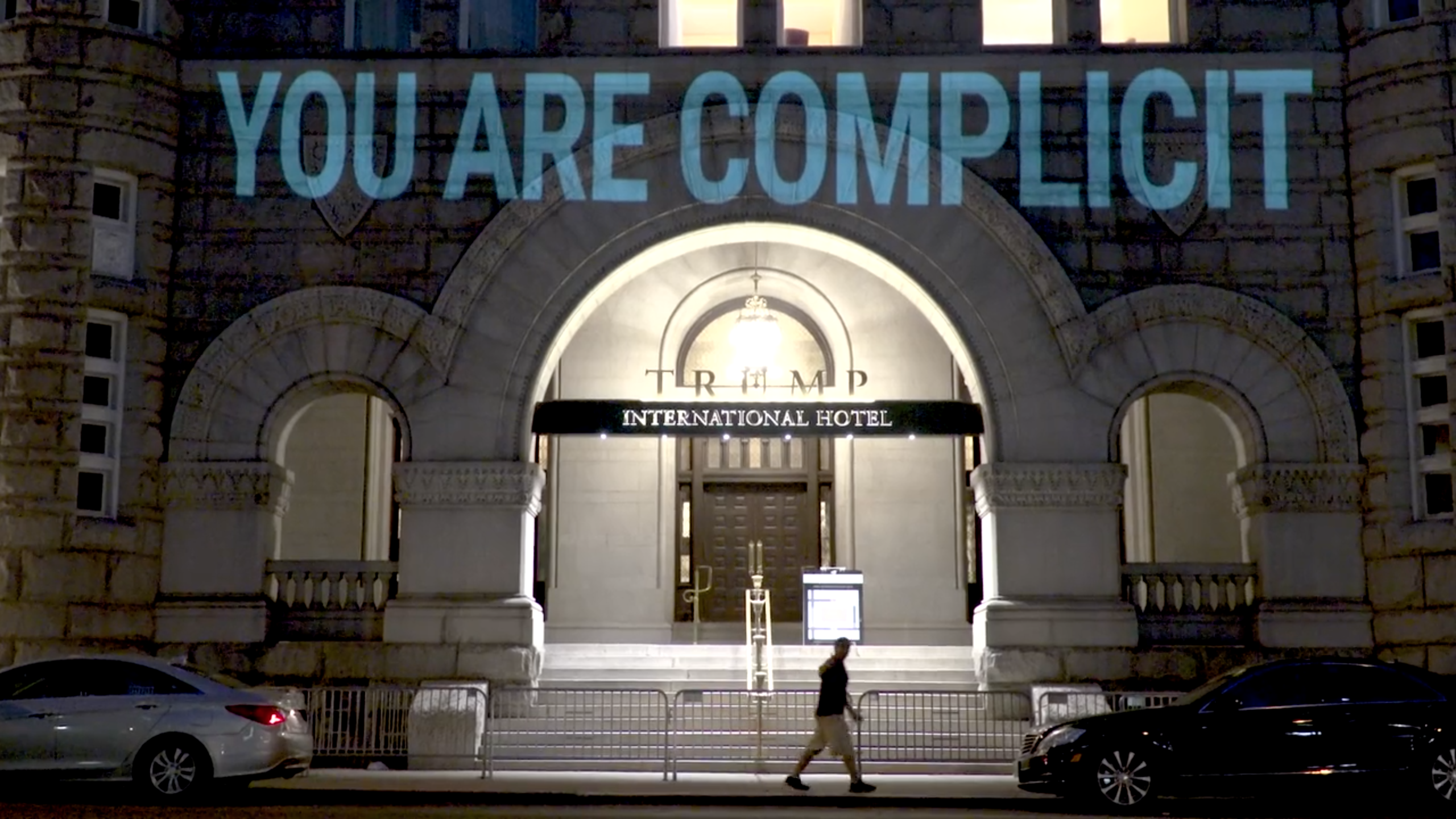By Ruth Steinhardt
Robin Bell’s latest projection art installation is called “OPEN.” But it will arrive at the Corcoran School of the Arts and Design this Thursday in the shadow of the longest government shutdown in United States history.
It is a dichotomy Mr. Bell has thought about often.
“As we’re speaking, the National Gallery of Art is closed,” he said in a January interview. “There’s literally a Leonardo DaVinci sitting in darkness in this city. That closure is a death.”
Mr. Bell is an activist and artist perhaps best known for his large-scale projections on the walls of the Trump Hotel and the E. Barrett Prettyman United States Courthouse, which drew attention to accusations against President Donald Trump and Supreme Court Justice Brett Kavanaugh respectively. In his view, a cohesive society is one that fights against the “deaths” represented by censorship, closure and erasure.
“We’re in the middle of a time when closure is being talked about—closed borders, closed thought, kind of a rise of authoritarianism around the world,” he said. “So as thinkers, as people and as educators we want to talk about openness.”
“OPEN” was not conceived as a reaction to the shutdown, which ended Jan. 25 after 35 days. Rather, its direct inspiration is an event 30 years in the past.
The exhibit is a companion and prelude to upcoming Corcoran retrospective “6.13.89,” which will examine the cultural and institutional climate leading to the Corcoran Gallery of Art’s cancellation of a controversial show by photographer Robert Mapplethorpe.
The Corcoran was the first major institution due to display Mr. Mapplethorpe’s work after his death of complications from AIDS in 1989. But as the exhibit was partially funded by the National Endowment for the Arts, detractors—including some members of Congress—pointed to its images of violence and homoeroticism as a misuse of taxpayer money. Museum administrators ultimately bowed to that pressure, and the show was canceled.
Mr. Bell wasn’t old enough to be cognizant of the controversy at the time. But he would later teach at the Corcoran, and he has many friends who were part of the Washington, D.C., arts scene in the 1980s. To them, the cancellation was “gut-wrenching,” he said. Its effects on the art world still reverberate.
That is why Mr. Bell said he is energized by the possibilities of “6.13.89.”
“I’m really excited about what the school’s doing with the show in June—to take that inward look and explore the why and how,” he said. “The strength of an artistic and educational institution is to have those hard conversations, those debates. When we see closure, how do we fight to re-open spaces so these conversations can actually happen?”
And spaces matter, Mr. Bell said. During his on-site projections, he sees his audience as a miniature community composed equally of devoted art enthusiasts and casual passers-by, who come together despite different ages, backgrounds, perspectives and beliefs. In Mr. Bell’s view, honest and vulnerable dialogues can happen on sidewalks in a way they can’t on Twitter.
So it is important to him that “OPEN” is physically situated in the Corcoran’s historic Flagg Building, the second floor of which reopened for student use last semester.
“The D.C. arts scene loved, and loves, this place, so to see the doors closed was this horrible thing—170 years of art being inaccessible,” he said. “Now that it’s reopened, what does that mean?”
The Flagg Building’s location also has enormous resonance for Mr. Bell. He has pictured the title of his new exhibit projected on its outer walls, directly across from the security gate by which visitors enter the White House: OPEN, the welcoming, familiar letters that glow from a favorite restaurant or all-night corner store.
“The building was built specifically for art to be across the street from power,” he said, and for Mr. Bell, openness is a question of democracy.
“In order to have free thought you have to talk about issues,” he said. “You have to be very wary when an institution says, ‘We don’t want to have a community represented, we don’t want to have this discussion.’ The big struggle we’re facing as a country and a world is, how do we remain open?”
There is no easy answer, Mr. Bell said, because openness is not a destination at which a society can arrive and rest. Rather, it’s a constant effort.
“The real challenge we have right now is admitting we don’t know,” he said. “We might have been wrong with an issue, we might have been wrong about a situation, there might be things we don’t know. We have to be willing to work and evolve.”
The opening night reception for “OPEN” takes place Feb. 7 at 6 p.m. Guests may RSVP at go.gwu.edu/bell. The exhibition is on view to the public from Feb. 7 to March 31, open Tuesday to Friday from 10 a.m. to 6 p.m. and Saturdays and Sundays from 1 to 6 p.m. at the Flagg Building, 500 17th St., NW.


